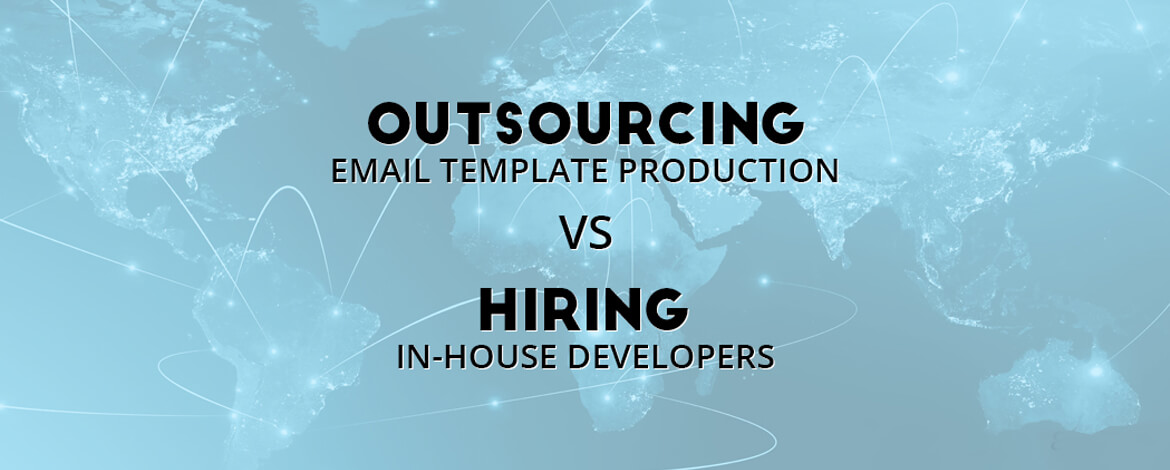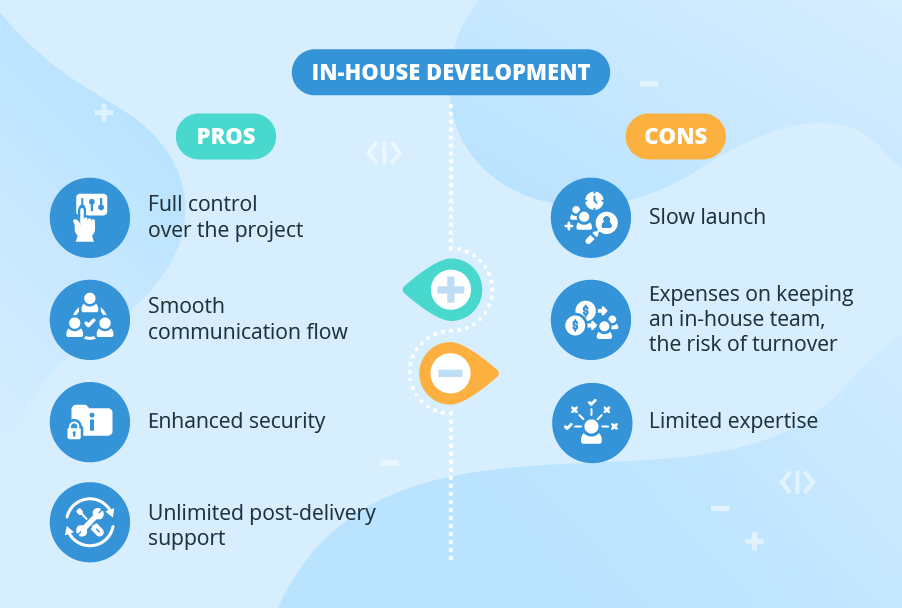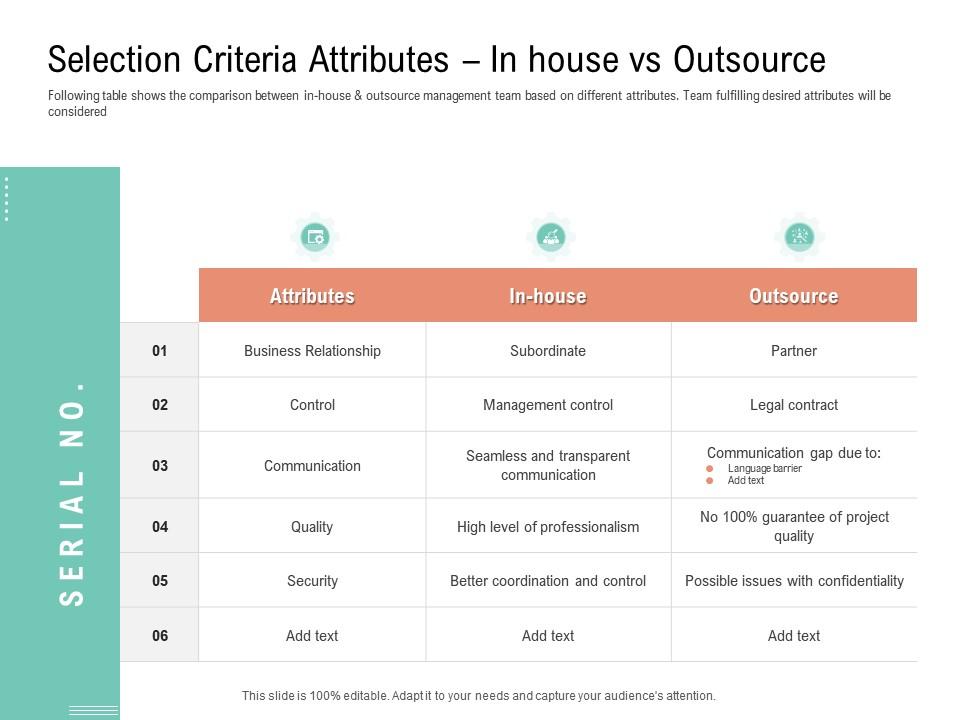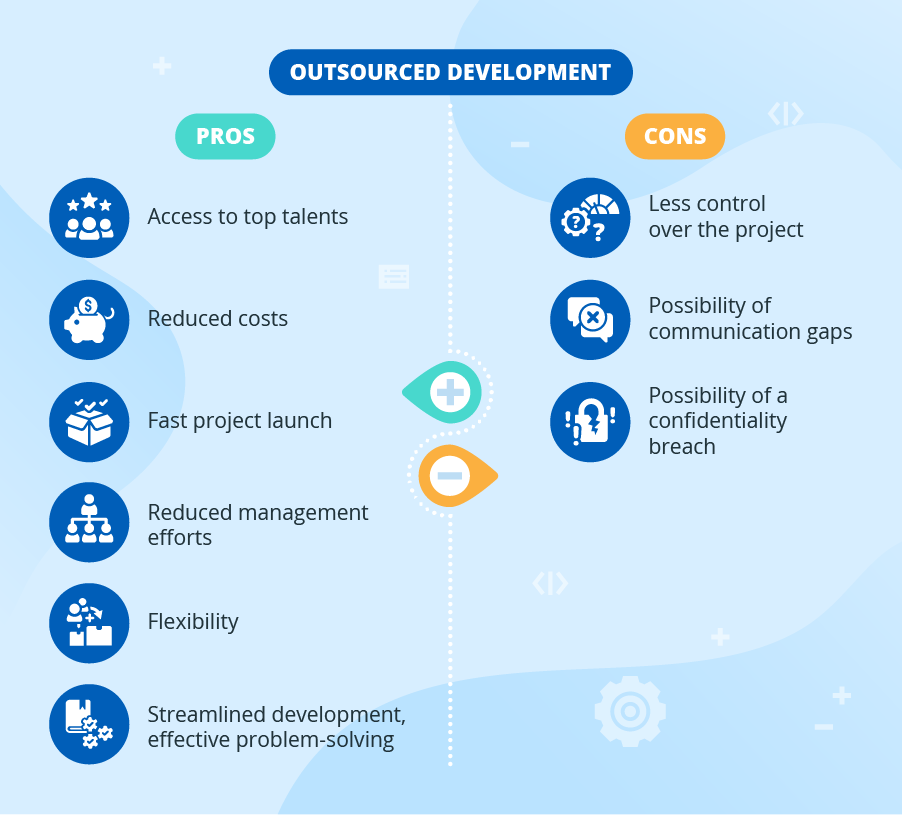Maximizing Efficiency: In-House vs. Outsourcing in 2024
:max_bytes(150000):strip_icc()/TermDefinitions_Outsourcing-410e9120dbc44211a93c2716b883db05.jpg)
In today's fast-paced world,maximizing efficiency has become crucial to the success of any business.
One area where this can be accomplished is through in-house operations or outsourcing.
While both options have their pros and cons, it's important to carefully consider each one before making a decision that can impact your bottom line.
In this article, we'll explore the benefits and challenges of each approach in 2024.
Quick Summary
- Outsourcing can save money, but not always. Hidden costs like communication and quality control can add up.
- In-house teams can be more invested in the company's success. They have a better understanding of the company culture and goals.
- Outsourcing can provide access to specialized skills. It can be difficult to find and hire experts for short-term projects in-house.
- In-house teams can provide faster turnaround times. They are readily available and can prioritize urgent projects.
- Outsourcing can provide flexibility. It allows companies to scale up or down quickly without the need to hire or lay off employees.
Introduction: The Importance Of Maximizing Efficiency

Maximizing Efficiency: 5 Key Points for Your Business
Efficiency is crucial for any business operation, regardless of size or scale.
In today's fast-paced world, businesses need to stay ahead of the competition by being efficient in everything they do - from managing employees and resources to marketing strategies and customer service
Maximizing efficiency reduces costs while increasing profits; it should be a top priority for all entrepreneurs.
Outsourcing
- Outsourcing certain tasks can free up internal resources
- In-house teams may provide better quality control
- Combining outsourcing with automation tools can increase productivity significantly
Streamlining Communication
- Streamlining communication channels improves collaboration among team members
Performance Metrics
- Regularly reviewing performance metrics helps identify areas where improvements are needed
If you're running an e-commerce store but struggling with order fulfillment due to limited staff capacity, consider outsourcing this task so that your team can focus on other critical aspects like product development or customer support.By doing so efficiently through proper vendor selection criteria such as cost-effectiveness analysis based upon factors including location proximity & expertise level matching requirements etc., not only will you save time but also reduce errors leading ultimately towards higher profitability levels!
Maximizing efficiency is not just about cutting costs; it's about doing more with less.
By implementing these five key points, you can optimize your business processes and achieve greater success.
Analogy To Help You Understand
Deciding whether to keep a task in-house or outsource it is like deciding whether to cook at home or eat out.
Just like cooking at home, keeping a task in-house gives you complete control over the process. You can customize the task to your exact needs and preferences, and you have the ability to make changes on the fly. However, just like cooking at home, keeping a task in-house can be time-consuming and may require specialized skills or equipment. On the other hand, outsourcing a task is like eating out at a restaurant. You can choose from a variety of options and find a solution that fits your budget and timeline. Outsourcing also allows you to tap into specialized expertise and resources that you may not have in-house. However, just like eating out, outsourcing can be unpredictable and may not always meet your expectations. Ultimately, the decision to keep a task in-house or outsource it depends on your specific needs and circumstances. Just like deciding whether to cook at home or eat out, it's important to weigh the pros and cons and choose the option that best fits your goals and resources.Understanding In House Operations

Maximizing Efficiency: Analyzing In-House Operations
Efficiency is crucial for any business, and as an industry expert, I know how to achieve it.
One way to do this is by analyzing your in-house operations carefully.
This means identifying each step involved in delivering a product or service and evaluating their strengths and weaknesses.
“Organizing the right team members with specific skills under effective leadership can guide them towards achieving organizational goals while keeping costs down.”
Five Things to Consider
To understand your in-house operation better, consider these five things:
- Analyze workflow patterns
- Evaluate employee productivity
- Identify bottlenecks
- Review current policies and procedures
- Determine which steps can be outsourced
“Analyzing workflow patterns can help identify tasks that are taking longer than expected due to poor communication between departments, leading to delays and inefficiencies.”
Evaluating employee productivity is also crucial.
It helps identify areas where they need improvement by providing feedback through performance reviews.
This results in increased motivation levels among staff who feel valued when given constructive criticism regularly.
“Regularly reviewing current policies and procedures can help identify areas where changes can be made to improve efficiency.”
Outsourcing certain steps can also be a great way to increase efficiency
By determining which steps can be outsourced, you can focus on the core competencies of your business and leave the rest to experts.
Some Interesting Opinions
1. In-house customer service is a waste of resources.
According to a study by Deloitte, outsourcing customer service can save companies up to 60% in costs. In-house teams are often less efficient and require more training and management.2. Outsourcing is the only way to stay competitive.
A survey by Accenture found that 85% of companies outsource to reduce costs and stay competitive. In-house teams can't match the speed, expertise, and scalability of outsourced providers.3. In-house AI development is a mistake.
Research by Gartner shows that 80% of in-house AI projects fail to deliver business value. Outsourced AI development can tap into a wider talent pool, reduce costs, and provide faster results.4. Outsourcing doesn't compromise quality.
A study by the Harvard Business Review found that outsourced providers often outperform in-house teams in quality, innovation, and customer satisfaction. Outsourcing allows companies to access specialized skills and technologies.5. In-house talent is overrated.
A report by McKinsey shows that 40% of companies struggle to find and retain top talent. Outsourcing can provide access to a global talent pool, reduce turnover, and increase diversity and innovation.Benefits And Drawbacks Of Keeping Operations In House

Keep Operations In-House: Benefits and Drawbacks
As an industry veteran with over 20 years of experience, I know that businesses face a critical decision between keeping their operations in-house or outsourcing them.
In this article, I will explore the benefits and drawbacks of choosing to keep your operations in-house.
Benefits of Keeping Operations In-House
- Complete Control: You have complete control and oversight over all aspects of your business.
This allows you to customize processes according to specific needs without relying on external factors while ensuring consistent quality standards throughout production.
- Faster Communication: With everyone working under one roof, communication happens quickly.
- Better Collaboration: Teams can work together more efficiently with fewer barriers.
- Increased Security: Sensitive information remains confidential since there are no third-party vendors involved.
- Greater Flexibility: You have greater freedom regarding changes made during projects as they arise instead of waiting for an outsourced vendor's response time.
Drawbacks of Keeping Operations In-House
However, one potential drawback could be limited diversity when it comes to knowledge and expertise if not adequately cultivated within the team.
Additionally, higher costs may result from hiring additional staff members who possess specialized skills needed for certain tasks.
You have complete control and oversight over all aspects of your business.
Sensitive information remains confidential since there are no third-party vendors involved.
You have greater freedom regarding changes made during projects as they arise instead of waiting for an outsourced vendor's response time.
While keeping operations in-house has its benefits, it's essential to weigh the drawbacks and determine what's best for your business.
Outsourcing 9: A Brief Overview

Outsourcing 9: The Future of Business
Outsourcing has been a buzzword for some time, but one type is making waves - Outsourcing 9.
As someone who's experienced outsourcing firsthand, let me explain why this form is increasingly popular.
Outsourcing 9 delegates non-core business functions to offshore locations where they're completed at lower costs without sacrificing quality.
Companies outsource sub-processes like data entry or software development to countries with cheaper labor rates such as India and the Philippines.
This model saves money by accessing global talent pools while maintaining high-quality standards.
Outsourcing 9 is the future of business.It's a game-changer that allows companies to focus on their core competencies while reducing costs and accessing global talent pools.
5 Key Takeaways About Outsourcing 9
- Delegating Non-Core Business Functions: Outsourcing 9 focuses on delegating non-core business functions.
- Lower Costs Without Sacrificing Quality: Offshore locations complete tasks at lower costs without sacrificing quality.
- Commonly Outsourced Sub-Processes: Sub-processes like data entry or software development are commonly outsourced.
- Countries with Cheaper Labor Rates Benefit: Countries with cheaper labor rates (e.g., India and the Philippines) benefit from this practice.
- Accessing Global Talent Pools: Accessing global talent pools allows companies to save money while still meeting high-quality standards.
Outsourcing 9 is a win-win situation for both companies and offshore locations.Companies can reduce costs while maintaining quality, and offshore locations can benefit from increased employment opportunities.
Outsourcing 9 is the future of business.
My Experience: The Real Problems
1. In-house teams are overrated.
According to a study by Deloitte, 59% of companies outsource to reduce costs and increase efficiency. In-house teams can be expensive and lack the expertise of specialized outsourcing firms.2. Outsourcing can lead to better quality work.
A survey by Clutch found that 78% of businesses that outsource are satisfied with the quality of work. Outsourcing allows companies to access a wider pool of talent and specialized skills.3. In-house teams can create a toxic work environment.
A study by Harvard Business Review found that employees who work in toxic environments are 54% more likely to quit. In-house teams can create a culture of competition and favoritism, leading to high turnover rates.4. Outsourcing can lead to job loss.
A report by the Economic Policy Institute found that outsourcing has led to the loss of 3.4 million jobs in the US since 2001. However, outsourcing can also create new jobs and opportunities in other areas.5. In-house teams can hinder innovation.
A study by McKinsey found that companies that embrace external partnerships and collaborations are more likely to innovate. In-house teams can become complacent and resistant to change, hindering innovation and growth.Advantages And Disadvantages Of Outsourcing

Outsourcing: Weighing the Pros and Cons
As an outsourcing expert, I know that businesses must weigh the pros and cons before making a decision.
Advantages:
- Cost savings: Hiring external firms or contractors can avoid expenses associated with recruiting and training employees in-house.
- Access to cheaper labor markets: Outsourced labor often comes from regions where wages are lower than those in developed countries.
- Flexibility: During peak seasons or project-based workloads, companies can easily scale up by bringing on additional workers through an outsourced provider instead of having to hire full-time staff members permanently.
Outsourcing can provide significant cost savings and flexibility for businesses.
Disadvantages:
- Loss of control over quality standards: Third-party vendors may not always maintain the same level of quality as conducted internally.
Outsourcing can lead to a loss of control over quality standards.
While outsourcing can provide significant benefits, it's important to carefully consider the potential drawbacks before making a decision.
Case Study One: Successful Implementation Of In House Model

How to Successfully Implement an In-House Model
Last year, I worked with a client who impressed me by implementing an in-house model.
Within six months, they experienced increased productivity and cost savings due to quality control issues faced while outsourcing.
They started small but gradually expanded their team over time until they could handle every aspect of production in-house.
They invested heavily in equipment and personnel training which paid off handsomely for them both financially and operationally.
“This case study highlights how well executing an in-house model can work if done properly.”
Key Takeaways
- Transition slowly to avoid disruptions.
- Invest significantly into necessary equipment or skills when adopting new models.
- Prioritize employee training as it is crucial for success.
- Continuously monitor progress through data analysis.
- Be prepared for initial challenges that come with any change but stay committed towards long-term goals.
Implementing an in-house model can be a game-changer for businesses.
However, it requires careful planning and execution.
By following these key takeaways, you can successfully implement an in-house model and reap the benefits.
“Remember, investing in your business is investing in your future success.”
My Personal Insights
When I first started my business, I was faced with the decision of whether to keep all operations in-house or outsource certain tasks. It was a tough decision, as both options had their pros and cons. However, I soon realized that outsourcing certain tasks, such as customer service, was not the best option for my business. I found that outsourcing led to a lack of control over the quality of service provided to my customers. That's when I decided to create AtOnce, an AI writing and customer service tool that allowed me to keep all customer service operations in-house. With AtOnce, I was able to provide my customers with a personalized and efficient experience, while also maintaining control over the quality of service provided. AtOnce allowed me to streamline my customer service operations, saving me time and money in the long run. It also allowed me to focus on other important aspects of my business, such as product development and marketing. Overall, my experience with outsourcing taught me the importance of keeping certain operations in-house. With AtOnce, I was able to provide my customers with the best possible experience, while also maintaining control over the quality of service provided.Case Study Two: Successful Implementation Of Outsourced Model

Case Study: How Outsourcing Helped Company AtOnce Achieve Digital Success
Company AtOnce faced difficulties keeping up with digital trends and couldn't afford expert content creators.
So they outsourced from an agency.
The results were astounding!
Consistency on all platforms was maintained, and engagement rates increased by 40%.
Outsourcing allowed them to focus on core business objectives instead of meeting deadlines or updating social media daily.
The agency provided guidance based on data analytics and market research that identified new growth opportunities.
Outsourcing provides access to cutting-edge technologiesIt frees up time for businesses to concentrate on their main goals
Agencies can offer valuable insights into industry trends through data analysis
Think about outsourcing as hiring a personal trainer at the gym - you may not have the expertise yourself but want someone who does so you can achieve your fitness goals efficiently without worrying about how it's done.
Similarly, outsourcing allows companies access to specialized skills while freeing up resources internally for other important tasks like product development or customer service improvements
Key Takeaways:
- Outsourcing provides access to cutting-edge technologies.
- It frees up time for businesses to concentrate on their main goals.
- Agencies can offer valuable insights into industry trends through data analysis.
In conclusion, outsourcing should be considered as part of any company's overall strategy if there are areas where internal teams lack expertise or bandwidth constraints exist due to budgetary limitations or competing priorities within organizations themselves.
Key Factors To Consider When Deciding Whether To Outsource Or Not

Outsourcing vs In-House: Which is More Cost-Effective?
When it comes to deciding whether to outsource or keep things in-house, cost is a crucial factor.
It's essential to evaluate all expenses associated with both options, including:
- Salaries
- Benefits
- Overhead costs like rent and utilities
- Additional fees required by outsourcing companies
Quality control is another vital consideration.
In-house teams have more direct oversight over their work processes than outsourced firms do.
This can lead to better end products but also means using more time on management tasks instead of directly working on projects themselves.
Outsourcing can offer a wider range of lower priced services due to cultural differences between clients who offer jobs based while residing abroad which helps mitigate missed deadlines caused by timezone issues.
However, outsourcing also comes with its own set of challenges, such as:
- Language barriers
- Cultural differences
- Communication difficulties
Ultimately, the decision to outsource or keep things in-house depends on the specific needs and goals of your business.
Developing A Cost Effective Process For Maximal Output

Increase Efficiency and Maximize Output with Cost-Effective Processes
In today's fast-paced business environment, developing a cost-effective process for maximum output is crucial.
To achieve this goal, there are several factors to consider:
- Automation
- Technology infrastructure
- Human resources
The first step towards the best cost-effective processes involves automating repetitive tasks as much as possible.
Automation eliminates manual errors while saving time and reducing costs associated with labor-intensive processes.
This approach allows you to accomplish more within the same timeframe resulting in maximal output.
Efficient Technology Infrastructure
Efficient technology infrastructure also improves productivity by enhancing communication channels among team members leading to timely feedback which ensures better workflow management ultimately maximizing output based on my experience.
Clear-Cut Standard Operating Procedures
Developing clear-cut SOPs (standard operating procedures) further streamlines operations ensuring that everyone understands their roles clearly hence minimizing confusion or delays due to lack of clarity about what needs doing next.
Optimizing all three aspects; automation of repetitive tasks where applicable, efficient tech-infrastructure & well-defined standard operating procedures will lead organizations into achieving optimal results at minimal operational expenses.
Streamlining Communication Channels For Optimal Collaboration

Streamlining Communications: Essential Tips for Successful Collaboration
Clear communication channels are crucial for successful collaboration.
You can use AtOnce's team collaboration software to manage our team better & save 80%+ of our time:
As a veteran writer in this industry, I know that establishing transparent lines of communication within your team and with any outsourced partners is key.
Regular check-ins and meetings should be set up where everyone can touch base on project status updates, share feedback, ask questions, and collaborate in real-time.
“To achieve success, it's important to establish transparent lines of communication within your team and with any outsourced partners you may be working with.”
To facilitate better communication across teams, there are several tools available:
- Project management software: Use tools like Trello or Asana to track progress on shared tasks while providing updates when changes occur.
- Cloud-based file-sharing services: Utilize services like Dropbox or Google Drive to give all stakeholders secure access to relevant documents from anywhere at any time so information is always readily available.
By following these simple steps, you'll ensure clarity and consistency throughout the entire process leading towards optimal collaboration between all parties involved!
“Clear communication channels are crucial for successful collaboration.”
Here are some essential tips for streamlining communications:
- Establish regular check-ins/meetings: Set up regular check-ins and meetings where everyone can touch base on project status updates, share feedback, ask questions, and collaborate in real-time.
- Use project management software: Utilize tools like Trello or Asana to track progress on shared tasks while providing updates when changes occur.
- Utilize cloud-based file sharing services: Use services like Dropbox or Google Drive to give all stakeholders secure access to relevant documents from anywhere at any time so information is always readily available.
Measuring Outcome Based Data Vs Output Based Data Analytics Which Is Better
Measuring Success: In-House vs. Outsourcing Solutions
As an industry expert, I've found that measuring the success of in-house vs. outsourcing solutions requires considering two types of data analytics: outcome-based and output-based.
Outcome-based data focuses on achieving end results or goals while output-based measures track work completed.
Both have strengths and weaknesses depending on specific needs.
Outsourcing Solutions
When evaluating outsourced solutions, focusing more heavily on outcomes like customer satisfaction rates is crucial rather than simply how much offshore team members worked to achieve it.
Outsourcing can provide cost savings and access to specialized expertise, but it's important to prioritize outcomes to ensure success.
In-House Solutions
Managing an in-house team or project involves analyzing outputs such as time spent per task for valuable insights into individual worker efficiency which ultimately drives productivity levels up over time.
Investing in in-house solutions can lead to greater control and flexibility, but it's important to track output-based measures to ensure efficiency.
Conclusion
Ultimately, the decision to use in-house or outsourcing solutions depends on specific business needs and goals.
By considering both outcome-based and output-based data, businesses can make informed decisions that drive success.
Conclusion: Final Thoughts On Maximising Efficiency In Business
The Importance of Balancing In-House and Outsourcing Activities
Maximizing efficiency is crucial for businesses, and finding the right balance between in-house and outsourcing activities is key.
Outsourcing certain tasks, such as digital marketing or customer support services, can be effective during periods of high demand.
However, keeping core operations within your company ensures tight control over quality standards.
The Minimum Level of Internal Capability
Every business should have a minimum level of internal capability to maintain control over strategic functions deemed too important to outsource.
Otherwise, there's a risk of losing opportunities.
Factors to Consider
Deciding whether to go with an in-house or outsourced approach depends on various factors, such as budget constraints and availability of external talent.
Both need careful consideration before making any decisions.
By striking this delicate balance between these two approaches based on individual needs and circumstances will help companies achieve their goals while maintaining optimal levels of productivity without sacrificing quality standards – something which is essential for long-term success!
Final Takeaways
As a founder of a startup, I know firsthand the importance of making the right decisions when it comes to building a team. One of the biggest decisions a company can make is whether to keep certain tasks in-house or outsource them. When I first started my company, AtOnce, I was faced with this decision. As a small team, we had to decide whether to hire additional staff to handle customer service or outsource it to a third-party provider. After careful consideration, we decided to outsource our customer service. It was a tough decision, but we knew that it would allow us to focus on our core competencies and grow our business faster. However, we quickly realized that outsourcing came with its own set of challenges. Communication was often difficult, and we had little control over the quality of service our customers were receiving. That's when we decided to develop our own AI customer service tool using our expertise in AI writing. With AtOnce, we were able to bring customer service back in-house without having to hire additional staff. Our AI tool allows us to provide fast and efficient customer service while maintaining control over the quality of service our customers receive. It also frees up our team to focus on other important tasks, such as product development and marketing. Ultimately, the decision to keep tasks in-house or outsource them depends on the specific needs and goals of your company. But with AtOnce, we've found a solution that works for us and allows us to provide the best possible service to our customers.Are you struggling to come up with new content ideas?
- Do you spend hours writing and editing your blog posts with little ROI?
- Are you looking for a way to streamline your email marketing efforts?
- Do you want to stand out from the competition with compelling product descriptions?
Introducing AtOnce - the AI writing tool that helps you generate high-quality, conversion-focused content in minutes.
How AtOnce Works- Enter your topic or keyword
- Choose your style - persuasive, informative, or creative
- Get instant content ideas, outlines, and even the first draft
The Benefits of AtOnce
- Save time and effort - no more staring at a blank screen or wasting hours on writing, editing, and formatting
- Get better results - AtOnce uses AI and natural language processing to create content that speaks to your audience and converts them into customers
- Focus on your strengths - use AtOnce to handle your writing tasks while you focus on your core business activities
- Scale your content - whether you need one blog post or hundreds of product descriptions, AtOnce can handle any volume and any type of content
The Proof Is In The Pudding
Don't just take our word for it - here are some success stories from our happy customers:
- Increased blog traffic and engagement by 50%
- Generated $10,000 in sales from one Facebook ad
- Reduced email marketing costs by 75% while increasing open and click-through rates
- Boosted e-commerce revenue by 30% with compelling product descriptions
Join the bandwagon of successful businesses that rely on AtOnce's AI writing tool to achieve their content goals.
Try it now and see the difference!What are the benefits of in-house teams in 2023?
In-house teams in 2023 offer greater control over the project, better communication, and a deeper understanding of the company culture and values.
What are the benefits of outsourcing in 2023?
Outsourcing in 2023 offers access to specialized skills, cost savings, and flexibility in scaling up or down depending on project needs.
What factors should be considered when deciding between in-house and outsourcing in 2023?
Factors to consider when deciding between in-house and outsourcing in 2023 include the nature of the project, the required skills and expertise, the budget, and the timeline.
